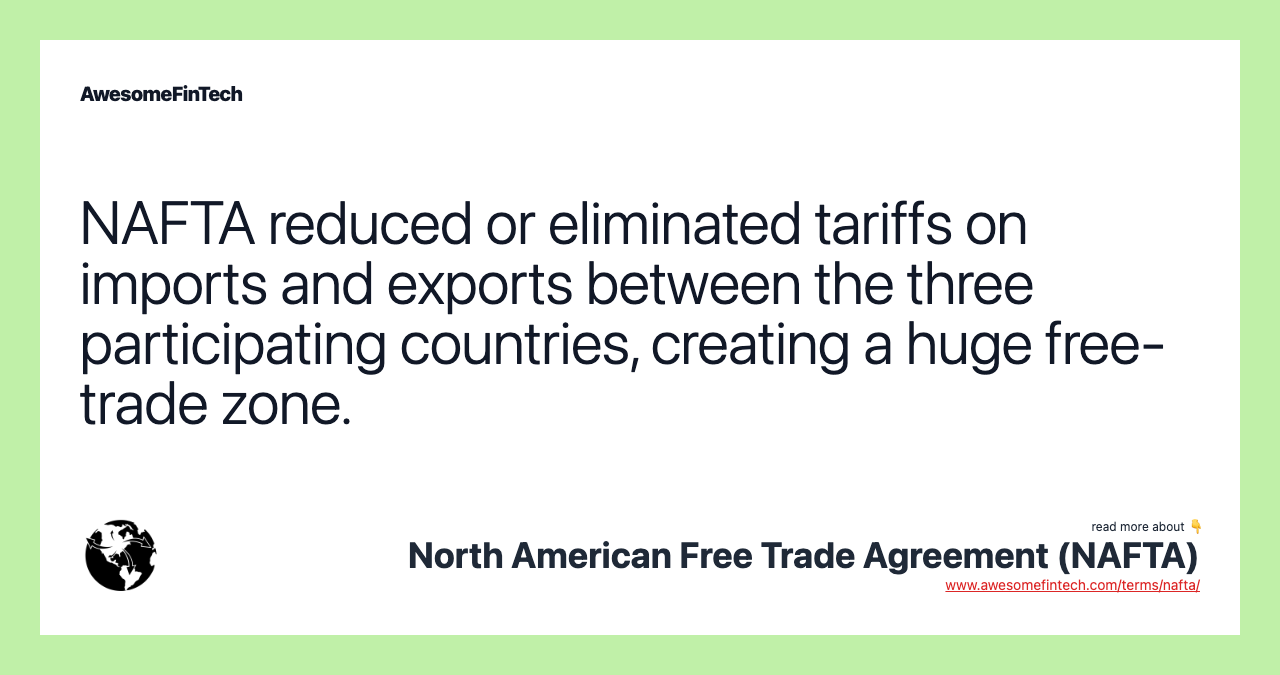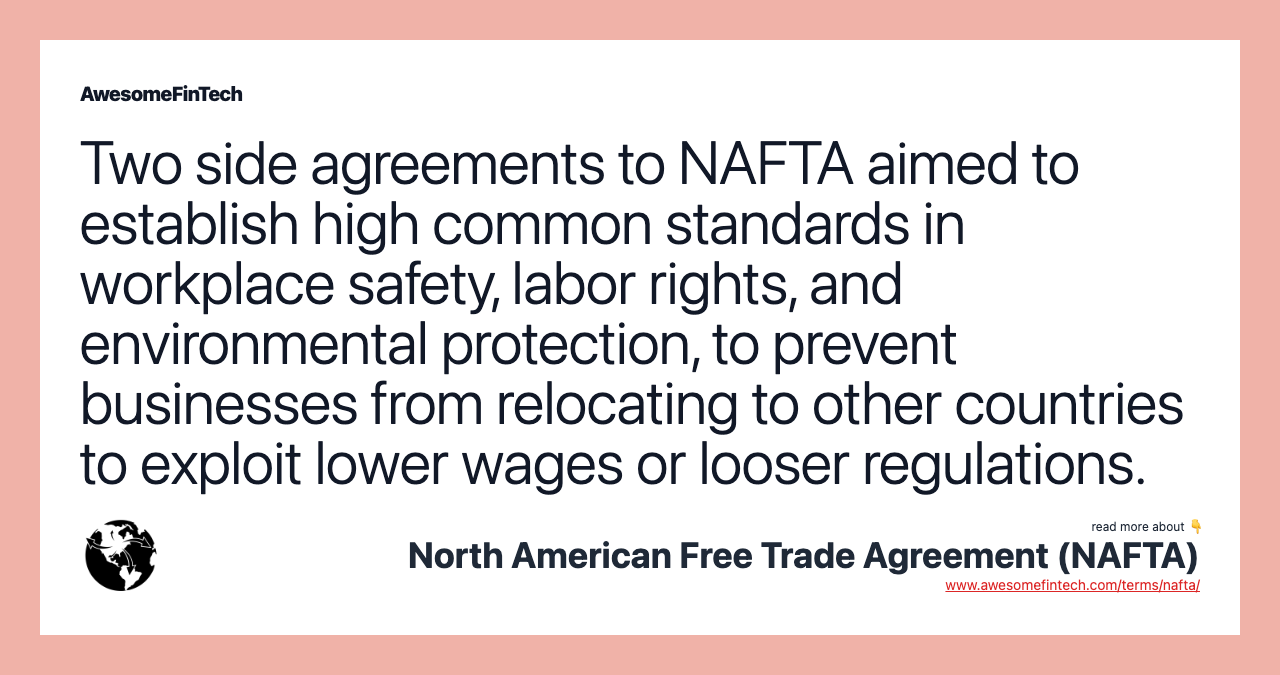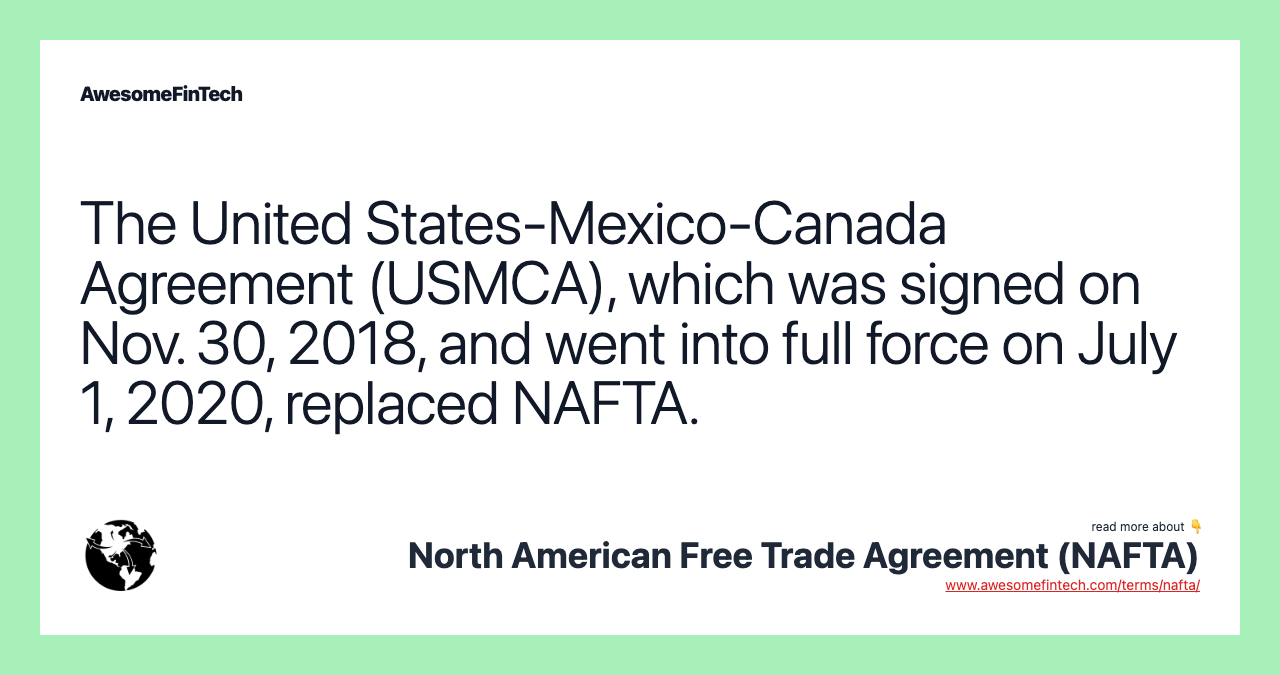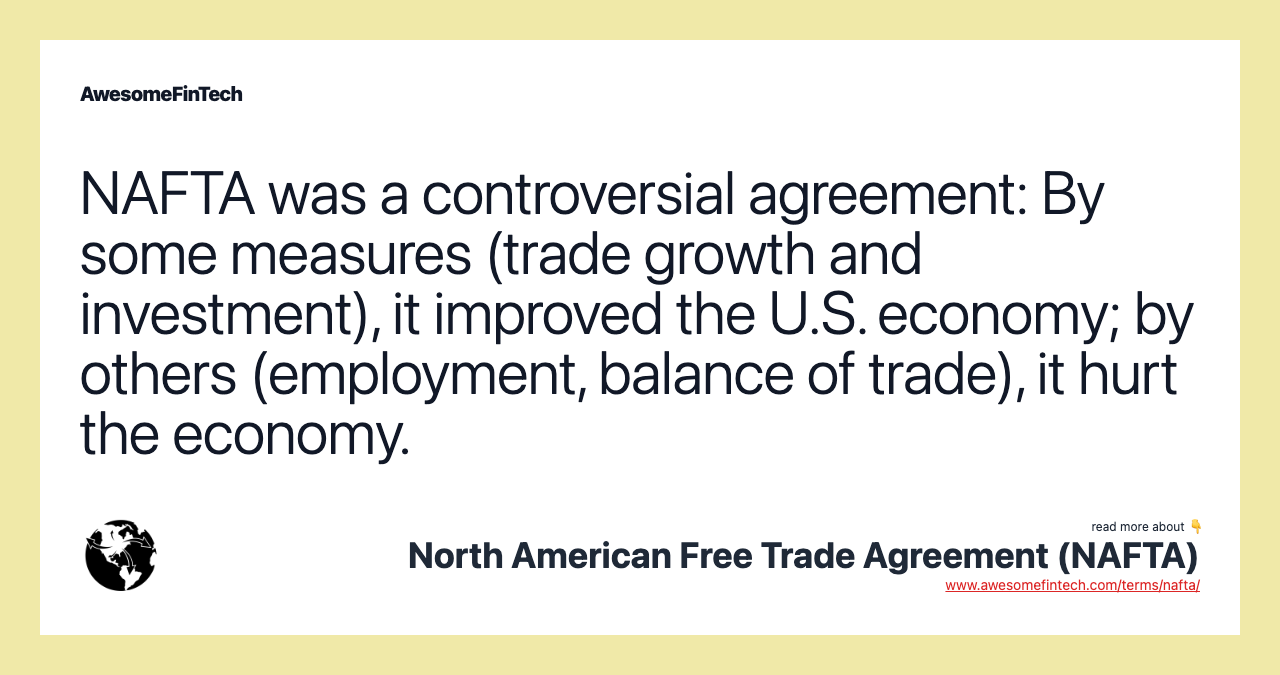North American Free Trade Agreement (NAFTA)
Table of Contents What Is NAFTA? Some critics also cite the rising wave of Mexican immigrants to the U.S. as a result of NAFTA — partly because the expected convergence of U.S. and Mexican wages didn’t happen, thus making the U.S. more attractive to Mexican workers. A spurred surge in cross-border trade and investment Increased competitiveness of U.S. industry Opened up opportunities for small businesses Implemented universal, higher health, safety, and environmental standards Caused loss of manufacturing jobs, especially in certain industries Increased inflation in the U.S. Increased U.S. trade deficits May have spurred Mexican immigration The U.S.-Mexico-Canada Agreement (USMCA) entered into force on July 1, 2020. History of NAFTA Additions to NAFTA North American Industry Classification System Pros and Cons of NAFTA NAFTA vs. USMCA NAFTA FAQs 62.5% of vehicle components must be made in North America 75% of components be North American in origin; 40%-45% of parts be from a factory paying $16/hour pharmaceuticals protections for certain drug classes from cheaper alternatives protections eliminated protected market in Canada, limiting access allows U.S. farmers access to up to 3.6% of the Canadian market and vice versa investor-state dispute settlement mechanism allows companies to sue governments for unfair treatment eliminated, except for certain Mexican industries intellectual-property protections treaty sunset provision treaty to be reviewed after 6 years; expires after 16 years unless extended While the United States, Canada, and Mexico have all experienced increased trade, economic growth, and higher wages (mainly in the northern nations) since NAFTA’s implementation, experts disagree on how much the agreement actually contributed to, if at all, U.S. manufacturing, jobs, immigration, and the price of consumer goods.

More in Economy
What Is the North American Free Trade Agreement (NAFTA)?
The North American Free Trade Agreement (NAFTA) was implemented to promote trade between the U.S., Canada, and Mexico. The agreement, which eliminated most tariffs on trade between the three countries, went into effect on Jan. 1, 1994. Numerous tariffs — particularly those related to agricultural products, textiles, and automobiles — were gradually phased out between Jan. 1, 1994, and Jan. 1, 2008.





Understanding NAFTA
NAFTA’s purpose was to encourage economic activity among North America's three major economic powers: Canada, the U. S., and Mexico. Proponents of the agreement believed that it would benefit the three nations involved by promoting freer trade and lower tariffs among Canada, Mexico, and the United States.
During the 2016 presidential election, Donald Trump campaigned on a promise to repeal NAFTA and other trade agreements he deemed "unfair" to the United States.
On Aug. 27, 2018, President Donald Trump announced a new trade deal with Mexico to replace NAFTA. The U.S.-Mexico Trade Agreement, as it was called, would maintain duty-free access for agricultural goods on both sides of the border and eliminate non-tariff barriers while also encouraging more agricultural trade between Mexico and the United States.
On Sept. 30, 2018, this agreement was modified to include Canada. The United States-Mexico-Canada Agreement (USMCA) took effect on July 1, 2020, completely replacing NAFTA. If not renewed, the USMCA will expire in 16 years.
A Sept. 30, 2018, joint press release from the U.S. and Canada Trade Offices stated:
“USMCA will give our workers, farmers, ranchers, and businesses a high-standard trade agreement that will result in freer markets, fairer trade, and robust economic growth in our region. It will strengthen the middle class and create good, well-paying jobs and new opportunities for the nearly half billion people who call North America home."
History of NAFTA
About one-fourth of all U.S. imports, such as crude oil, machinery, gold, vehicles, fresh produce, livestock, and processed foods, originate from Mexico and Canada, which are, respectively, the United States' second- and third-largest suppliers of imported goods, as of 2019. In addition, approximately one-third of U.S. exports, particularly machinery, vehicle parts, mineral fuel/oil, and plastics are destined for Canada and Mexico.
NAFTA legislation was developed during George H. W. Bush's presidency as the first phase of his Enterprise for the Americas Initiative. The Clinton administration, which signed NAFTA into law in 1993, believed it would create 200,000 U.S. jobs within two years and 1 million within five years because exports play a major role in U.S. economic growth. The administration anticipated a dramatic increase in U.S. imports from Mexico as a result of the lower tariffs.
Additions to NAFTA
NAFTA's provisions were supplemented by two other regulations: the North American Agreement on Environmental Cooperation (NAAEC) and the North American Agreement on Labor Cooperation (NAALC). These tangential agreements were intended to prevent businesses from relocating to other countries to exploit lower wages, more lenient worker health and safety regulations, and looser environmental regulations.
NAFTA did not eliminate regulatory requirements on companies wishing to trade internationally, such as rule-of-origin regulations and documentation requirements that determine whether certain goods can be traded under NAFTA. The free-trade agreement also contained administrative, civil, and criminal penalties for businesses that violate any of the three countries’ laws or customs procedures.
North American Industry Classification System
The three NAFTA signatory countries developed a new collaborative business-classification system that facilitates comparison of business activity statistics across North America. The North American Industry Classification System (NAICS) organizes and separates industries according to their production processes.
The NAICS replaced the U.S. Standard Industrial Classification (SIC) system, allowing businesses to be classified systematically in an ever-changing economy. The new system enables easier comparability between all countries in North America. To ensure that the NAICS remains relevant, the system is reviewed every five years.
The three parties responsible for the formation and continued maintenance of the NAICS are the Instituto Nacional de Estadística y Geografía in Mexico, Statistics Canada, and the United States Office of Management and Budget through its Economic Classification Policy Committee, which also includes the Bureau of Economic Analysis, Bureau of Labor Statistics, and the Bureau of Census. The first version of the classification system was released in 1997. A revision in 2002 reflected the substantial changes occurring in the information sector. The most recent revision, in 2017, created 21 new industries by reclassifying, splitting, or combining 29 existing industries.
The next scheduled review of NAICS will take place in 2022.
This classification system allows for more flexibility than the SIC's four-digit structure by implementing a hierarchical six-digit coding system and classifying all economic activity into 20 industry sectors. Five of these sectors are primarily those that produce goods, and the remaining 15 sectors provide some type of service. Every company receives a primary NAICS code that indicates its main line of business. A company receives its primary code based on the code definition that generates the largest portion of the company's revenue at a specified location in the past year.
The first two digits of a NAICS code indicate the company's economic sector. The third digit designates the company’s subsector. The fourth digit indicates the company's industry group. The fifth digit reflects the company’s NAICS industry, and the sixth designates the company’s specific national industry.
Advantages and Disadvantages of NAFTA
NAFTA's immediate aim was to increase cross-border commerce in North America, and it did indeed spur trade and investment among its three member countries by limiting or eliminating tariffs. It was especially advantageous to small or mid-size businesses, because it lowered costs and did away with the requirement of a company to have a physical presence in a foreign country to do business there.
Most of the increase came from trade between the U.S and Mexico or between the U.S. and Canada., though Mexico-Canada trade grew as well. Overall, there was $1.0 trillion in trilateral trade from 1993 to 2015, a 258.5% increase in nominal terms (125.2%, when adjusted for inflation). Real per-capita gross domestic product (GDP) also grew slightly in all three countries, primarily Canada and the U.S.
NAFTA protected non-tangible assets like intellectual property, established dispute- resolution mechanisms, and, through the NAAEC NAALC) side agreements implemented labor and environmental safeguards. It increased U.S. competitiveness abroad and "exported" higher U.S. workplace safety and health standards to other nations.
From the beginning, NAFTA critics were concerned that the agreement would result in U.S. jobs relocating to Mexico, despite the supplementary NAALC. In fact, many companies did subsequently move their manufacturing operations to Mexico and other countries with lower labor costs — in particular, thousands of U.S. auto workers and garment-industry workers were affected in this way. However, NAFTA may not have been the reason for all those moves.
During the NAFTA years, U.S. trade deficits (importing more from a nation than you export) did increase, especially with Mexico. So did inflation.
Some critics also cite the rising wave of Mexican immigrants to the U.S. as a result of NAFTA — partly because the expected convergence of U.S. and Mexican wages didn’t happen, thus making the U.S. more attractive to Mexican workers.
NAFTA vs. USMCA
The U.S.-Mexico-Canada Agreement (USMCA) entered into force on July 1, 2020. Basically, it builds on NAFTA, using the older legislation as a basis for a new agreement. But it does have some differences.
Another change moves the labor and environmental protections of the original side agreements into the main agreement, meaning issues like the right to organize are now subject to the pact’s normal procedures for settling disputes.
In particular, it revised and toughened labor laws relating to Mexico, establishing an independent investigatory panel that can investigate companies accused of violating workers' rights, and stop shipments from those found to be in violation of labor laws. It also compelled Mexico to enact a wide array of labor reforms, to improve working conditions and increase wages.
Here are some other distinctions between the two agreements, indicating qualifications for tariff-free status and other rules.
Comparing NAFTA and USMCA
Provision
62.5% of vehicle components must be made in North America
75% of components be North American in origin; 40%-45% of parts be from a factory paying $16/hour
pharmaceuticals
protections for certain drug classes from cheaper alternatives
protections eliminated
protected market in Canada, limiting access
allows U.S. farmers access to up to 3.6% of the Canadian market and vice versa
investor-state dispute settlement mechanism
allows companies to sue governments for unfair treatment
eliminated, except for certain Mexican industries
intellectual-property protections
treaty sunset provision
treaty to be reviewed after 6 years; expires after 16 years unless extended
NAFTA FAQs
What Was the Main Goal of NAFTA?
NAFTA aimed to create a free trade zone between the U.S., Canada, and Mexico. The goal was to make doing business in Mexico and Canada less expensive for U.S. companies (and vice versa), reducing the red tape needed to import or export goods.
How Did NAFTA Work?
Among its three member nations, NAFTA eliminated tariffs and other trade barriers to agricultural and manufactured goods, along with services. It also removed investment restrictions and protected intellectual property rights. Finally, its provisions addressed environmental and labor concerns, attempting to establish a common high standard in each country.
Is NAFTA Still in Effect?
No, NAFTA was effectively replaced by the United States-Mexico-Canada Agreement (USMCA). Signed on Nov. 30, 2018, it went into full effect on July 1, 2020.
Did NAFTA Help the U.S. Economy?
Whether NAFTA helped the U.S. economy is a matter of some debate. Certainly, trade between the United States and its North American neighbors more than tripled, from roughly $290 billion in 1993 to more than $1.1 trillion in 2016. Cross-border investments also surged, and U.S. GDP overall rose slightly.
How Did Canada Benefit From NAFTA?
"NAFTA has had an overwhelmingly positive effect on the Canadian economy. It has opened up new export opportunities, acted as a stimulus to build internationally competitive businesses, and helped attract significant foreign investment," states the Canadian government's website.
More specifically, since NAFTA went into full effect, U.S. and Mexican investments in Canada have tripled. U.S. investment alone grew from $70 billion in 1993 to more than $368 billion in 2013. Total merchandise trade between Canada and the United States more than doubled since 1993 and grew nine-fold between Canada and Mexico.
The Bottom Line
Debate continues surrounding NAFTA's impact on its signatory countries. There were significant gains, some serious losses — and some results that are hard to unravel.
While the United States, Canada, and Mexico have all experienced increased trade, economic growth, and higher wages (mainly in the northern nations) since NAFTA’s implementation, experts disagree on how much the agreement actually contributed to, if at all, U.S. manufacturing, jobs, immigration, and the price of consumer goods. Nor has NAFTA affected all three of its member nations to the same degree or in the same ways.
So, the overall, actual impact of the agreement is hard to isolate, especially from the lingering effects of the 2007-09 Great Recession, and other significant economic, technological, and industrial trends that have occurred on the continent and globally in the past quarter-century. Often, NAFTA gets blamed for developments that are not directly its fault, or that may have happened anyway.
In a sense, NAFTA stands as a symbol for globalization and free trade. So views and analyses of it are often projected through the lens of opinion about these subjects in general.
Related terms:
Bureau of Economic Analysis (BEA)
The Bureau of Economic Analysis (BEA), a division of the U.S. Department of Commerce, is responsible for the analysis and reporting of economic data. read more
Clintonomics
Clintonomics refers to the economic philosophy and policies promulgated by President Bill Clinton, who was president of the U.S. from 1993 to 2001. read more
Depression
An economic depression is a steep and sustained drop in economic activity featuring high unemployment and negative GDP growth. read more
Enterprise For The Americas Initiative (EAI)
A program to boost hemispheric trade unveiled by U.S. President George H. W. Bush on June 27, 1990. The primary objectives of the program were to establish a free-trade zone stretching across North and South America, expand investment and provide debt relief for Latin American and Caribbean countries. read more
Free Trade Agreement (FTA)
A free trade agreement reduces barriers to imports and exports between countries by eliminating all or most tariffs, quotas, subsidies, and prohibitions. read more
Free Trade Area Defintion
Free trade areas are groups of countries which sign free trade agreements to facilitate trade and reduce trade barriers. read more
Import
An import is a product or service produced abroad but then sold and consumed in your country. read more
Industry Group
An industry group is a classification method for companies based on common lines of business. read more
Maquiladora
A maquiladora is a Spanish term for a factory located near the United States-Mexico border that operates under a favorable duty- or tariff-free basis. read more
North American Industry Classification System (NAICS)
The North American Industry Classification System is a business classification system developed by the United States, Canada, and Mexico. read more